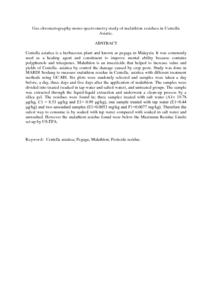Citation
Abdul Manaf, Latifah and David Musa, Rabecca and Abdul Latif, Puziah
(2011)
Gas chromatography mono spectrometry study of malathion residues in Centella Asiatic.
Iranian Journal of Environmental Health Science & Engineering, 8 (1).
pp. 57-64.
ISSN 1735-1979; ESSN: 1735-2746
Abstract
Centella asiatica is a herbaceous plant and known as pegaga in Malaysia. It was commonly used as a healing agent and constituent to improve mental ability because contains polyphenols and triterpenes. Malathion is an insecticide that helped to increase value and yields of Centella. asiatica by control the damage caused by crop pests. Study was done in MARDI Serdang to measure malathion residue in Centella. asiatica with different treatment methods using GC-MS. Six plots were randomly selected and samples were taken a day before, a day, three days and five days after the application of malathion. The samples were divided into treated (soaked in tap water and salted water), and untreated groups. The sample was extracted through the liquid-liquid extraction and underwent a clean-up process by a silica gel. The residues were found in; three samples treated with salt water (A1= 19.78 μg/kg, C1 = 8.53 μg/kg and E1= 0.99 μg/kg), one sample treated with tap water (E1=0.44 μg/kg) and two unwashed samples (E1=0.0053 mg/kg and F1=0.0077 mg/kg). Therefore the safest way to consume is by soaked with tap water compared with soaked in salt water and unwashed. However the malathion residue found were below the Maximum Residue Limits set up by US EPA.
Download File
![[img]](http://psasir.upm.edu.my/23537/1.hassmallThumbnailVersion/Gas%20chromatography%20mono%20spectrometry%20study%20of%20malathion%20residues%20in%20Centella%20Asiatic.pdf)  Preview |
|
PDF (Abstract)
Gas chromatography mono spectrometry study of malathion residues in Centella Asiatic.pdf
Download (185kB)
| Preview
|
|
Additional Metadata
Actions (login required)
 |
View Item |

